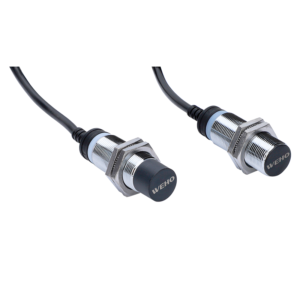When it comes to non-contact position sensing, two popular technologies often come up in comparison: inductive sensors and Hall effect sensors. Both are widely used across automotive, industrial, and consumer electronics applications, but they operate differently and have unique strengths.
This article answers the question: What is the difference between Hall sensor and inductive sensor? We’ll break down their definitions, key features, and the 8 core differences between them, helping you make the right decision for your application.
What is an Inductive Sensor?

An inductive sensor is a non-contact device that detects metallic objects without physical touch. It works based on electromagnetic induction. When a metallic object (usually ferrous) comes close to the sensing coil, the changing electromagnetic field alters the inductance, triggering a response in the sensor’s electronics.
Inductive sensors are commonly used in automation systems, manufacturing equipment, and harsh industrial environments due to their robustness and resistance to contaminants like dust, oil, and water.
What is a Hall Effect Sensor?

A Hall effect sensor detects the presence and strength of a magnetic field. It uses a semiconductor chip that generates a voltage (the Hall voltage) when a magnetic field is applied perpendicular to the current flow. This voltage change is then interpreted to determine the position, proximity, or speed of a magnetic object.
Hall sensors are used in automotive ignition systems, brushless DC motors, gear position detection, and many other applications that involve rotating parts and require precise magnetic field measurements.
8 Differences Between Hall Effect and Inductive Sensor
| Aspect | Hall Effect Sensor | Inductive Sensor |
|---|---|---|
| Working Principle | Uses magnetic field and electric current | Uses electromagnetic induction with metallic targets |
| Sensing Target | Needs a magnet | Needs a metal object (no magnet required) |
| Sensing Range | Longer range | Shorter range (a few millimeters) |
| Signal Output Type | Commonly analog and digital | Mostly digital (on/off) |
| Durability in Harsh Environments | Can be sensitive to dirt and vibration | Very durable; resistant to dust, water, and vibration |
| Magnetic Interference Immunity | Can be affected by magnetic fields | Not affected by magnetic fields |
| Temperature Resistance | May have signal drift in high temperatures | Stable performance at high temperatures |
| Installation Simplicity | Needs a magnet to be positioned carefully | Easier to install; only needs a metal target |
Working Principle
Hall effect sensors operate based on the interaction between magnetic fields and electric current. Inductive sensors, on the other hand, rely on changes in electromagnetic inductance caused by metallic targets.
Sensing Target
Hall effect sensors require a magnetic source such as a permanent magnet to function. Inductive sensors detect only metallic (usually ferrous) objects, with no need for a separate magnet.
Sensing Range
Hall sensors typically offer longer sensing distances since magnetic fields can extend over a wider range. Inductive sensors have shorter sensing ranges, typically a few millimeters, limited by the electromagnetic field strength and the size of the target object.
Signal Output Type
Both types can produce analog or digital outputs, but Hall sensors are more commonly used in analog signal applications due to their sensitivity to magnetic field variations. Inductive sensors often deliver digital (on/off) signals for presence detection.
Durability in Harsh Environments
Inductive sensors are solid-state devices with no moving parts, making them highly resistant to wear and tear, dirt, moisture, and vibration. Hall sensors, while durable, include sensitive electronic components near the sensing area, which can be more vulnerable to environmental factors.
Immunity to Magnetic Interference
Hall sensors are directly influenced by magnetic fields, which means nearby magnetic materials or electromagnetic interference can distort their readings. Inductive sensors do not rely on magnets, making them more immune to such interference.
Temperature Resistance
Inductive sensors typically offer better performance stability at high temperatures. Hall sensors can experience signal drift due to temperature changes, which affects measurement accuracy.
Installation Simplicity
Hall sensors require a magnet to be mounted with precision in relation to the sensing chip, which adds complexity to installation. Inductive sensors only need a metal target, which can be an existing part of the equipment, making them easier to integrate.
How to Choose Between Inductive and Hall Effect Sensors?
Choosing between an inductive sensor vs Hall effect sensor depends on your specific application requirements.
-
Choose Hall effect sensors if:
-
You need to measure magnetic fields or use magnets as triggers
-
Your application requires long-range sensing
-
You need analog signal output for precise control
-
-
Choose inductive sensors if:
-
You’re working with metallic targets
-
Your application involves dirt, oil, water, or vibration
-
You need a rugged sensor with high durability and low maintenance
-
Understanding the difference between Hall effect and inductive sensor technologies helps avoid performance issues and increases reliability in real-world applications.
Conclusion
The debate of Hall effect vs inductive sensor comes down to understanding the working principles, environmental conditions, and mechanical requirements of your project. Each sensor type has its advantages, and the best choice depends on your specific sensing goals. Whether you’re looking for long-range magnetic detection or robust metallic object sensing in industrial environments, this guide should help clarify the difference between Hall effect and inductive sensor technologies.
By recognizing the strengths and limitations of both, you can confidently select the sensor that ensures performance, reliability, and efficiency in your system.








